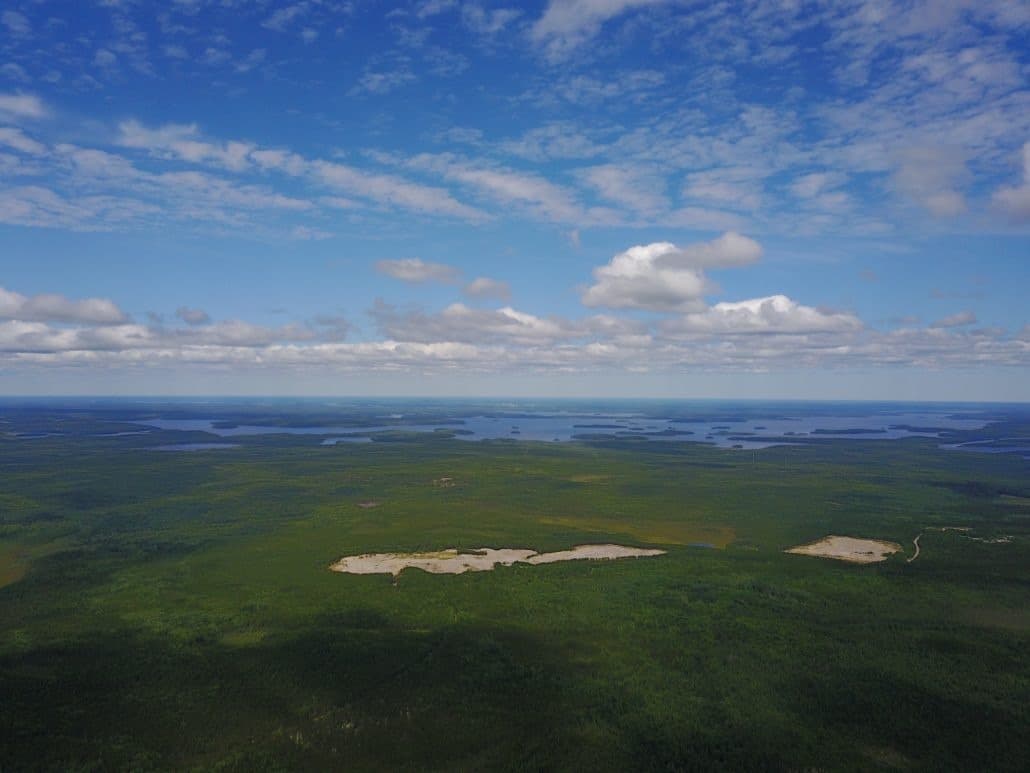Great Bear Resources, the Vancouver-based explorer has reported a significant new high-grade gold discovery, the “Bear-Rimini Zone”, at its 100% owned Dixie Project in the Red Lake District of Ontario
The first drill hole contains very positive results, including 2m at 194.21 g/t gold from 58m, 12.33 g/t gold over 14m including 30.9 g/t gold over 4.6m.

Chris Taylor, President and CEO of Great Bear, said that the company’s previous round of regional drilling helped them identify a significant hydrothermal alteration zone which helped them focus this first round of drilling.
“We tested and discovered, in our first hole, a new zone of shallow high-grade gold associated with silicification of host rocks related to a crustal-scale structure we call the LP Fault. The fault marks a contact between mafic and felsic/intermediate rocks and is spatially associated with an 80 to 200 metre wide quartz sericite zone associated with highly anomalous to high-grade gold mineralization. We interpret the LP Fault to transect the property for approximately 18 kilometres of strike length. The new Bear-Rimini Zone joins the Hinge Zone as a significant new gold discovery and will be an additional focus of drilling through the remainder of 2019.”
Highlights of Great Bear’s most recent discovery include:
- The Bear-Rimini Zone is located 2.5 kilometres northwest of the Hinge Zone.
- The new discovery is hosted by a new exploration target, the “LP Fault”, and adjacent lithologies. Airborne geophysics completed by Great Bear shows the LP Fault and a parallel structure, the “North Fault”, are interpreted to transect the property for 18 kilometres of strike length as shown on Figure 1.
- DNW-011 intersected intervals of gold mineralization across 110 metres of core length and were strongest in a coarse quartz crystal lapilli tuff unit in the northern footwall of the fault. This is the first drill hole in the project’s history to target this tuff unit. Complete assays from DNW-011 are provided in Table 2 at the end of this release.
- The LP Fault is interpreted as a major gold mineralization control and hydrothermal fluid conduit during Archean age gold mineralization. The generally 1 kilometre wide area between the LP and North Faults may represent a significant structural dilation zone where gold rich hydrothermal fluids accumulated.
- The LP Fault has a projected depth of 14 kilometres, extending to base of the continental crust/upper mantle as defined by the Lithoprobe Survey of the Red Lake district, as shown on Figure 2. A similar deep-seated structural feature was interpreted by the Survey to be spatially and genetically associated with the majority of gold mineralization along the main Red Lake mine trend (Zeng and Calvert, 2006) where over 30,000,000 ounces of gold have been produced.
- The LP Fault parallels highway 105, the main access corridor to Red Lake and is 1 to 3 kilometres from a powerline and paved road, and it is a 30 minute drive from the main Red Lake gold mine operated by Newmont Goldcorp Corp.
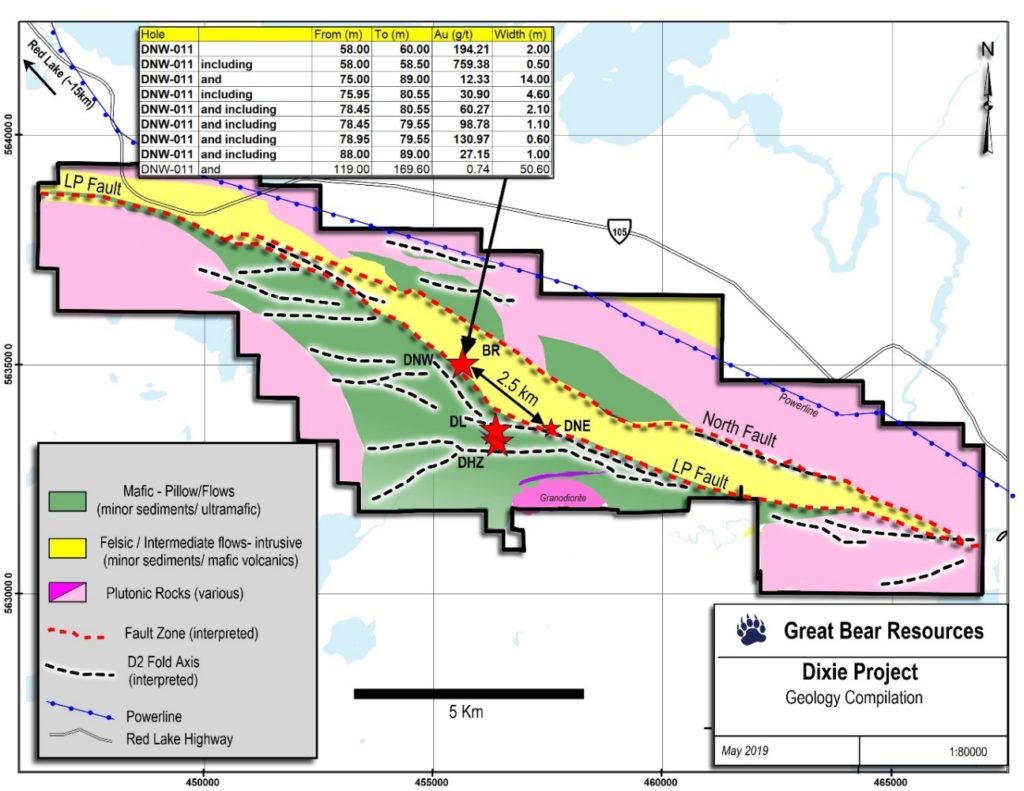

The Bear-Rimini Zone High-Grade Gold Discovery
- The shallowest current gold intercept in DNW-011 is only 53 metres vertically from surface; 759.38 g/t gold over 0.5 metres.
- A finer-scale map showing the location of the Bear-Rimini Zone, other gold zones and significant nearby drill intercepts into the LP Fault, with the location of the cross-section provided in this news release is provided in Figure 3.
- A cross section through the LP Fault and adjacent lithologies is shown on Figure 4.
- Gold in DNW-011 occurs as coarse to fine disseminations with minor accompanying sulphides as shown on Figure 5.
- DNW-011 was drilled from north to south across the quartz sericite zone Great Bear had previously intersected in hole DNW-008 (see news release of May 7, 2019; 34.6 metres of 0.55 g/t gold) and the LP Fault, and intersected two different zones of gold mineralization, which are distinguished by host rock type and proximity to the primary deformation zone within the LP Fault:
- High-grade gold is hosted by strained coarse quartz crystal lapilli tuff units affected by pervasive silica alteration (the “Silicified Zone”) to the north of the LP Fault.
- Anomalous to moderate gold grades are hosted by a “Quartz-Sericite Zone”within and immediately adjacent to the LP Fault, in significantly strained fine quartz crystal tuffs and fine-grained intermediate tuffs.
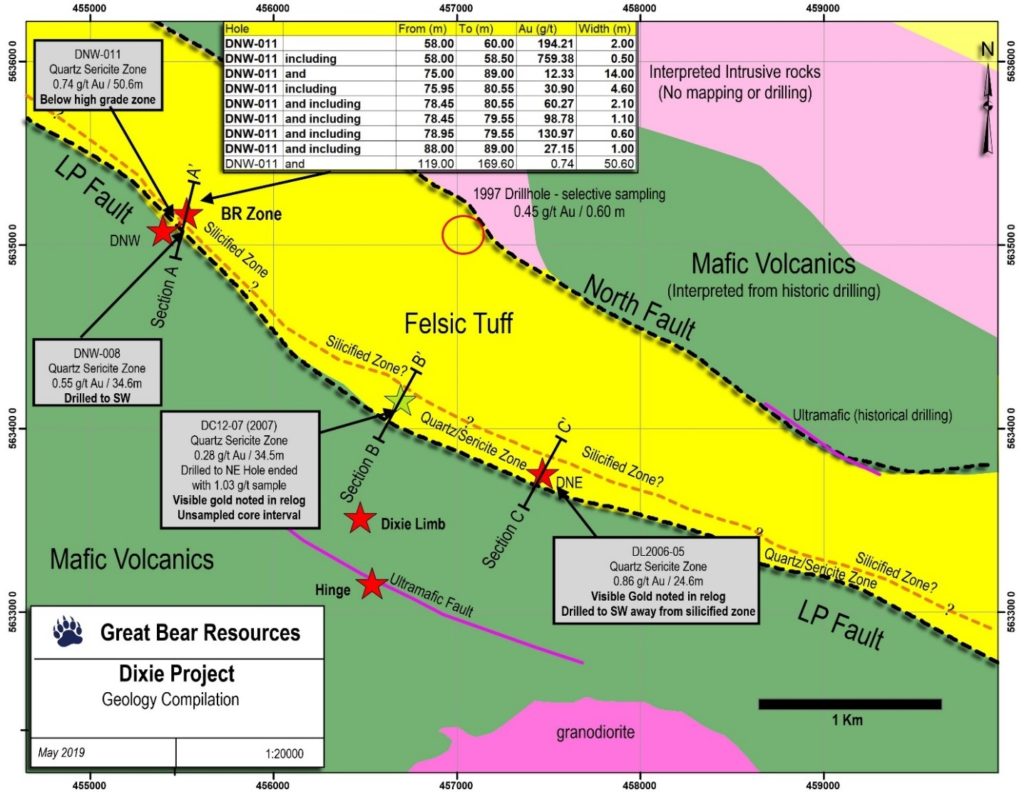
Strike Potential of the Bear-Rimini Zone
- A total of 15 drill holes completed by previous explorers and Great Bear have intersected the Quartz-Sericite Zone along 2.5 kilometres of strike length of the LP Fault. All 15 (100%) of these drill holes encountered anomalous to moderate gold grades matching those observed in the Quartz-Sericite Zone in DNW-011 and DNW-008. Highlighted results are provided in Figure 3.
- These historical drill holes are interpreted to have been drilled south of the Silicified Zone intersected by DNW-011 and stayed entirely within the Quartz-Sericite Zone. The DNE holes drilled closest to the projected Silicified Zone (i.e. furthest north) had higher gold grades, including visible gold in drill core. Up to 80% of the total core length of some historical drill holes were never split and assayed by past explorers. Great Bear is currently re-logging and assaying unsampled mineralized intervals of core from all available historical drill holes from the area.
- While the LP Fault has 18 kilometres of interpreted strike length, the number of mineralized zones that may be hosted by the fault and adjacent units is not yet known, and the structural corridor is not necessarily mineralized along its entire length.
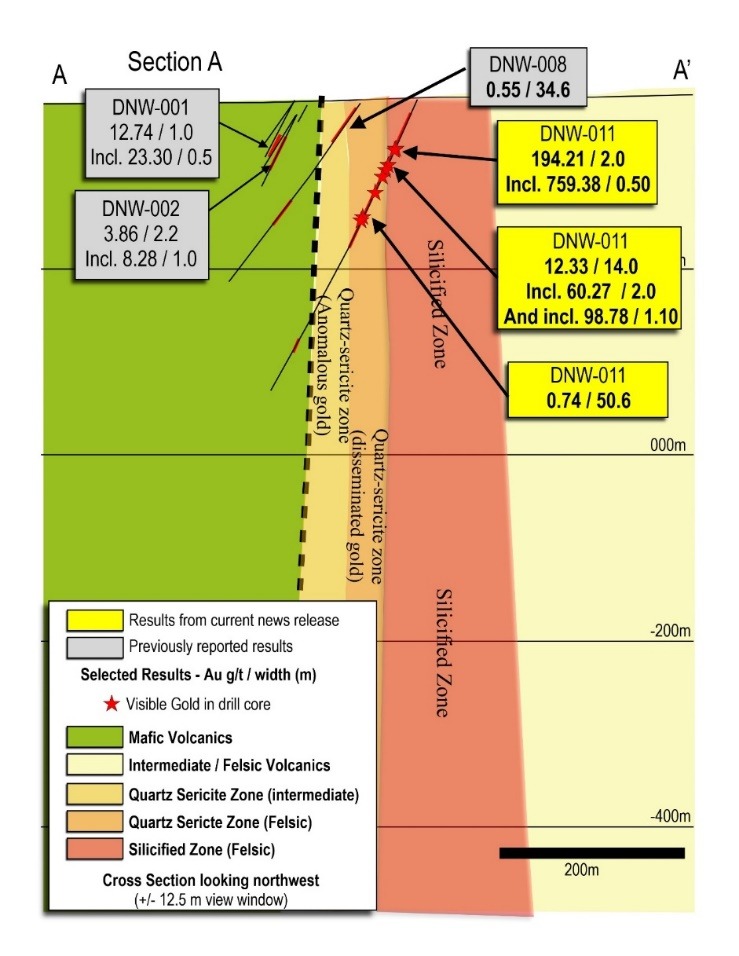
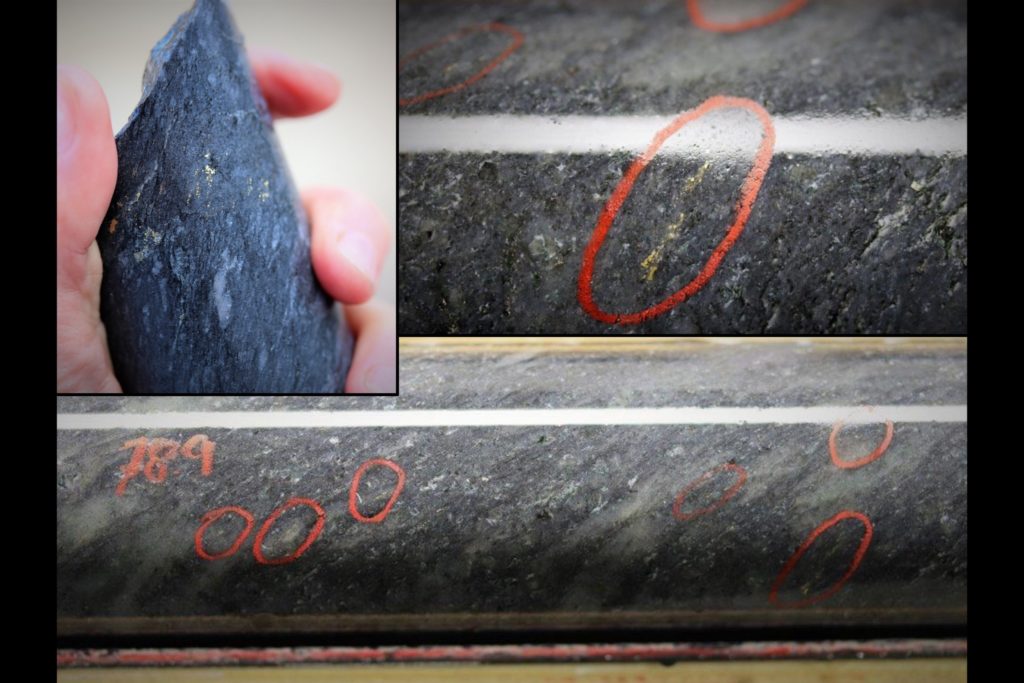
A three-dimensional representation of Great Bear’s model of gold mineralization at the Bear-Rimini discovery as it relates to the 18 kilometre strike length of the LP Fault and other gold zones is provided in Figure 6.
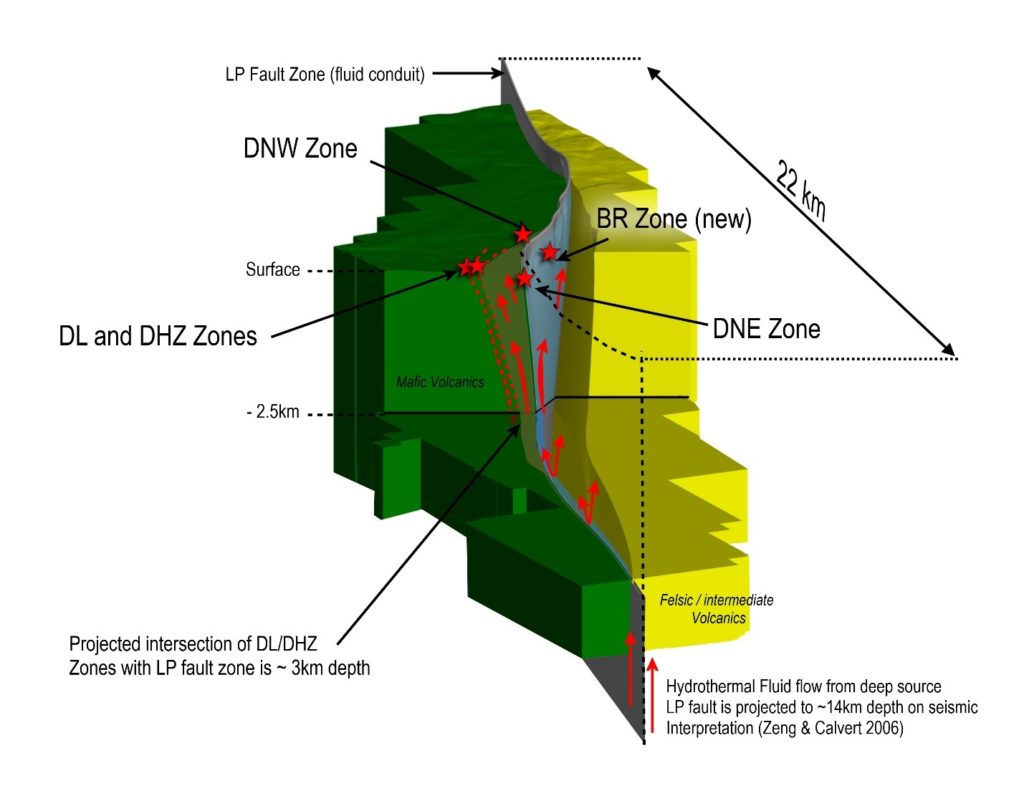
The Company continues to undertake a fully funded, 60,000 metre drill program that is expected to continue through 2019. In order to accelerate the program, a second drill rig was added in early 2019, and a third drill rig is expected in the near future. Approximately 40,000 metres of drilling remain in the current program.










